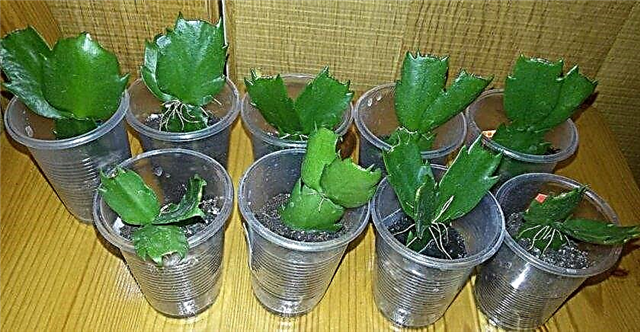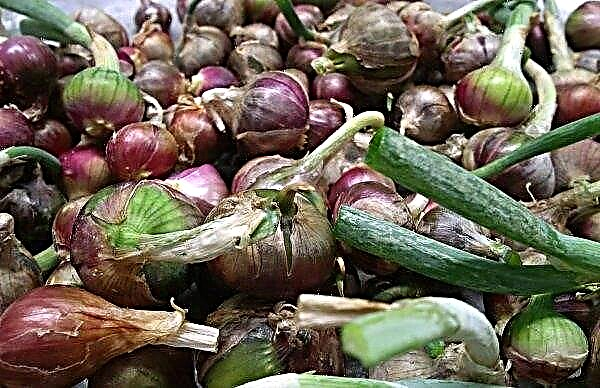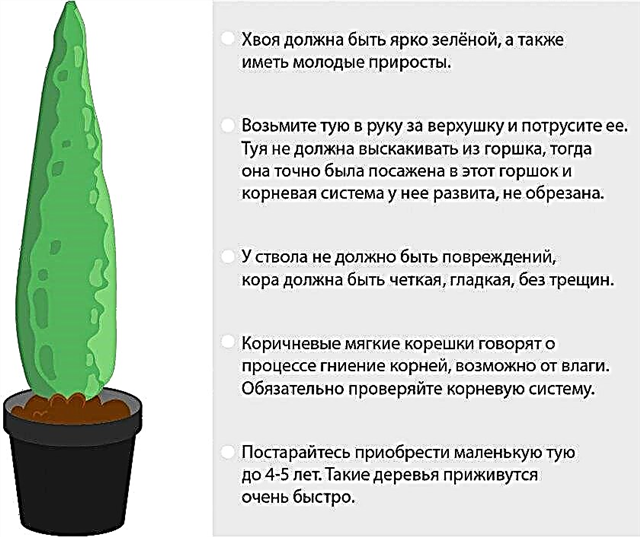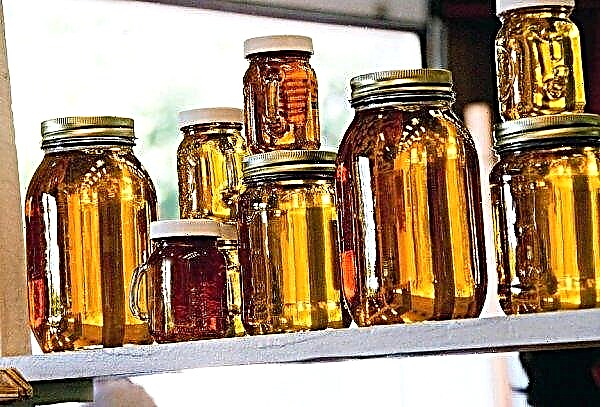The Decembrist (or zigocactus, “Schlumbergera” - in Latin) is a popular indoor flowering plant of the cactus family. The subtleties of its cultivation are devoted to this article.
Decembrist landing dates at home
The planting time of this houseplant depends on the planting material. Sowing seeds is best done in the warm season - in late spring or early summer. If we take into account vegetative propagation, then it is possible at any time of the year, with the exception of the flowering period of the mother plant. Usually, a period is selected for the procedure when the zygocactus has already faded.

Preparation for landing
The Decembrist is grown in ordinary pots, and in hanging, as ampelous species of plants. The natural habitat of Schlumbergera is tropical rainforests, so it is important to provide a suitable microclimate for it.
Optimal conditions and choice of place
South and southwest window sills are not suitable for zygocactus, direct sunlight is contraindicated to it. During a period of high sun activity, it is recommended to shade the flowerpot, otherwise its foliage will begin to turn yellow, and the buds may crumble.
The optimum comfortable temperature of plant growth is + 18 ° C– + 25 ° C. In the summer, you can take the flower to fresh air, in a place protected from drafts.
Rozhdestvennik (the so-called plant) loves high humidity. If it is extremely undesirable to fill the soil, then it is necessary to spray the space around the pot.Did you know? The flower located in the bedroom draws out the negative energy accumulated during the day. The owner of the Decembrist wakes up in the morning vigorous and completely rested.
Material and pot size
It is important to correctly determine what size of the pot the plant needs. The Decembrist has a superficial root system, so too deep a capacity is not good. Moisture will accumulate at its bottom, which short roots cannot absorb. This will lead to waterlogging of the soil and, ultimately, to rotting of the roots.
The pot for the Christmas tree can be plastic or clay.
Both materials are suitable, but growing in them has its own nuances:
- a good drainage layer is required in a plastic pot, since the material is not porous, excess moisture will not evaporate, but accumulate in the soil;
- clay, not covered with glaze, conducts heat well; due to its numerous pores, it evaporates moisture and transmits oxygen. The disadvantage is that over time, stains from deposits of salts appear on the walls;
- glazed clay has good thermal conductivity, but the glaze partially closes the pores.
Did you know? One of the superstitions associated with the Decembrist promises lack of money to the owner of the plant, if it has never bloomed in a year.
Preparation of soil for planting
The soil for the Decembrist should be fertile and porous.
For self-preparation of the soil mixture take such components (the proportion is: 2: 1: 1: 1):
- turf land;
- leaf humus;
- peat;
- coarse sand.

How to plant Decembrist at home
You can grow a Christmas tree vegetatively (cuttings, grafting) or seeds.
Cuttings
The harvesting of cuttings is combined with the trimming procedure. You can plant one segment or process with 2–4 segments. It is best to take for planting cuttings with aerial roots, which the plant forms in the process of growth.
Germination is performed by two methods:
- In water.
- In the ground.

Features of growing plants in water:
- the process is "unscrewed" manually from the main stem, left to dry for several hours;
- water is poured into a small container, which should cover the upper part of the handle;
- water is periodically changed;
- when the roots appear, the stalk is transplanted into the ground.
- When growing from one segment or leaf into the ground, several copies are planted at once in a circle.
- The selected cuttings are treated with Kornevin growth stimulator.
- Do not tamp the soil in the pot.
- If there are no roots, they are planted in the ground, completely deepening one segment. In the presence of aerial roots, the stalk is buried by 1-1.5 cm.

Graft
This manipulation is carried out mainly by professional flower growers to improve the characteristics of the plant. A cactus plant (prickly pear or peresius) is also taken as a stock. The graft is a stalk of 2-3 segments.
The vaccination technology is as follows:
- The deciduous mass is removed from the top of the stock.
- An incision is made with a sharp knife into which the stalk is placed.
- The place of vaccination is tightly wrapped with a dense thread.
- The plant is placed in an area with diffuse lighting at a temperature not lower than + 18 ° С.
- When new Decembrist segments appear, the thread is removed.
Video: Vegetative propagation of the Decembrist
Seeds
For sowing, you can purchase universal soil for flowering plants.
Sowing technology is already different:
- Seeds are washed (do not soak!) In a solution of potassium permanganate.
- For sowing, it is better to take a food container with a lid.
- The material is placed on the surface of moistened soil.
- Cover with a lid or film and place in a warm (+ 25 ° C) place.
- Every day, the crops are aired, and if the soil has dried up, they are sprayed with warm water.
- It is better to keep the sowing tank under the light of an artificial lamp at a certain distance.
- After the appearance of 2 segments, seedlings dive into separate pots.

Aftercare for indoor plants
In addition to the usual care, the plant needs attention for a period of dormancy and flowering. The period of bud formation is in the winter months, so zigocactus rests in the fall. At this time, maintain a temperature of + 10 ° C– + 15 ° C. At the end of November, in order to “wake up” the Decembrist, the pot is taken out in the usual warm conditions, providing lighting and watering.
Important! Do not lower the room temperature below + 10 ° С. If the roots of the Decembrist are frozen, he will die.
Feeding and watering
Water for irrigation should be warm, settled. If the room where the spraying is carried out is dry air, it can be moistened twice a day. In the spring-summer period, they are watered abundantly, draining excess fluid from the pallet and not filling the plant. For the rest period, watering is practically stopped, just try not to allow the soil to completely dry out. In winter, during the formation of buds and flowering, it should be moderate.
Video: Watering and feeding Decembrist
Around March, the flower needs additional nutrition. The ideal option for top dressing is for flowering plants. It is enough to feed the plant once a month.
In the summer, the Christmas tree is fed twice a month with complex mineral fertilizers. During rest, nothing needs to be fertilized. Fertilizers should not be administered immediately after leaving hibernation: this can become a stress for the flower, because of which it will lose buds.
Important! The dosage of complex fertilizers should be half as much as indicated in the instructions for the drug.
Trimming and shaping a bush
The basic rule for trimming (whether it is a shaping or anti-aging procedure) is not to trim the segments, but to unscrew them manually. To form a beautiful crown, remove all knocked out along the length, curved and weak shoots.
Anti-aging pruning consists in shortening adult shoots, which stimulates the formation of young segments. June is considered the best time for such a procedure.
Plant transplant
Young specimens are transplanted annually after a period of rest, changing the capacity to a more spacious one. Adult plants need to change the pot every 3-4 years (terms - immediately after flowering).
When transplanting, the soil is completely changed, since the Decembrist depletes it, drawing out all the nutrients. The soil mixture is taken with peat content (as described above). The soil lump is not completely cleaned from the roots because of fears of damaging them. To root the plant after transplantation, the pot should be removed at partial shade for 2-3 days.
Plant diseases and pests
The main diseases of the Decembrist are provoked by increased soil moisture.
These include:
- Fusarium
- root rot;
- late blight.

If you are infected with a pest (mealybug or spider mite), you need to use insecticidal drugs ("Actara", "Fitoverm"). Fighting the mealybug, the plant segments are washed with a mild soapy solution.
Useful Care Tips
Rozhdestvennik is one of the few indoor plants blooming in winter; its flowering period can last up to 3 months.
To achieve this, you need to take into account all the subtleties of leaving:
- During dormancy, care is minimal, the place is cool, no top dressing.
- Exclude any temperature differences, drafts. Lower and raise the temperature gradually.
- During flowering, do not touch the pot. Turn to the light during active growth.
- In winter, daylight hours are extended using artificial lighting.
- Flowering will last longer at temperatures up to + 16 ° C. It will be more magnificent if the capacity is narrow.

Zigocactus is a moody plant, but its long flowering and the appearance of large bright flowers are worth the effort. A variety of varieties and hybrids (including Schlumberger) will decorate any collection of indoor flowers.















